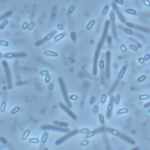Link to Pubmed [PMID] – 32903654
Link to DOI – 10.3389/fmicb.2020.01939
Front Microbiol 2020 ; 11(): 1939
The emerging human enteropathogen Clostridioides difficile is the main cause of diarrhea associated with antibiotherapy. Regulatory pathways underlying the adaptive responses remain understudied and the global view of C. difficile promoter structure is still missing. In the genome of C. difficile 630, 22 genes encoding sigma factors are present suggesting a complex pattern of transcription in this bacterium. We present here the first transcriptional map of the C. difficile genome resulting from the identification of transcriptional start sites (TSS), promoter motifs and operon structures. By 5′-end RNA-seq approach, we mapped more than 1000 TSS upstream of genes. In addition to these primary TSS, this analysis revealed complex structure of transcriptional units such as alternative and internal promoters, potential RNA processing events and 5′ untranslated regions. By following an in silico iterative strategy that used as an input previously published consensus sequences and transcriptomic analysis, we identified candidate promoters upstream of most of protein-coding and non-coding RNAs genes. This strategy also led to refine consensus sequences of promoters recognized by major sigma factors of C. difficile. Detailed analysis focuses on the transcription in the pathogenicity locus and regulatory genes, as well as regulons of transition phase and sporulation sigma factors as important components of C. difficile regulatory network governing toxin gene expression and spore formation. Among the still uncharacterized regulons of the major sigma factors of C. difficile, we defined the SigL regulon by combining transcriptome and in silico analyses. We showed that the SigL regulon is largely involved in amino-acid degradation, a metabolism crucial for C. difficile gut colonization. Finally, we combined our TSS mapping, in silico identification of promoters and RNA-seq data to improve gene annotation and to suggest operon organization in C. difficile. These data will considerably improve our knowledge of global regulatory circuits controlling gene expression in C. difficile and will serve as a useful rich resource for scientific community both for the detailed analysis of specific genes and systems biology studies.

